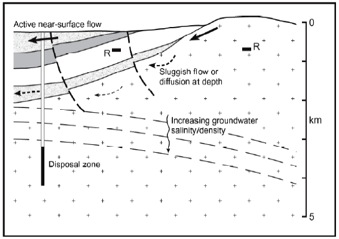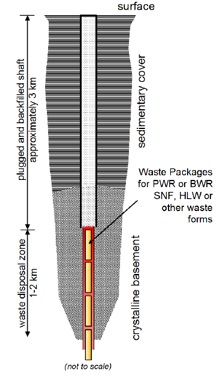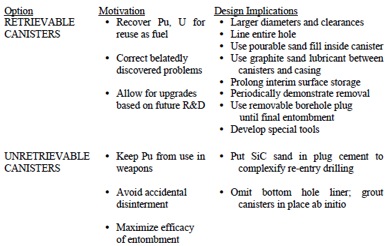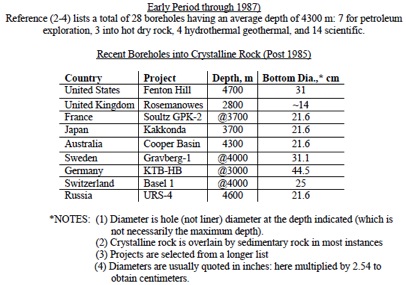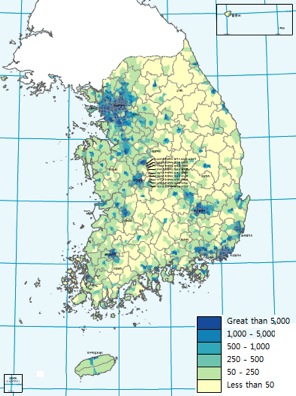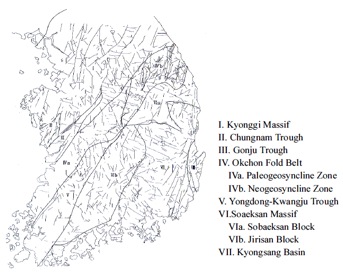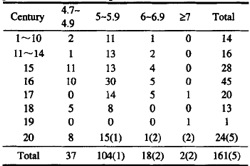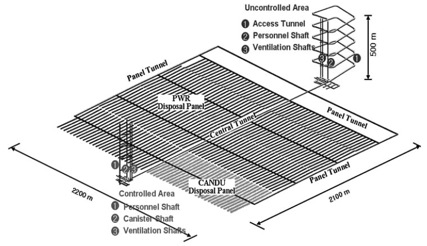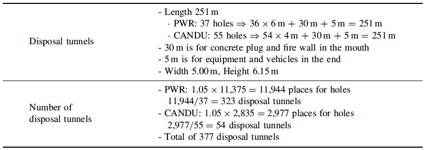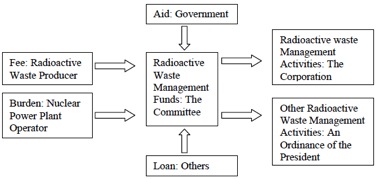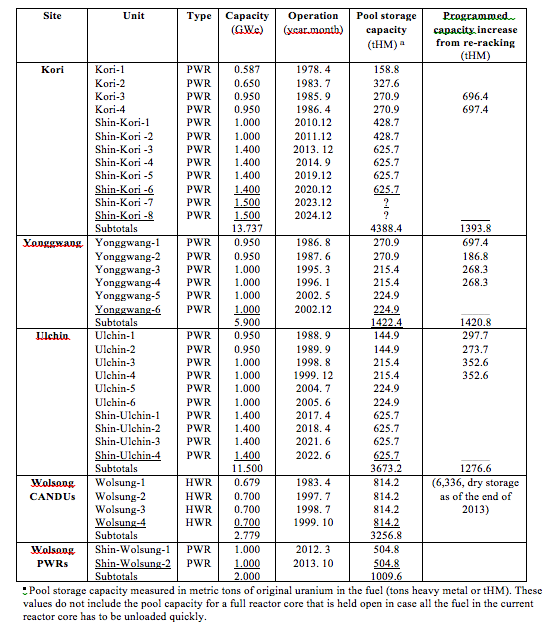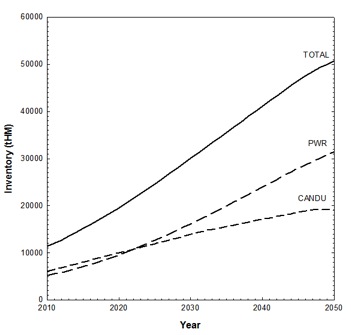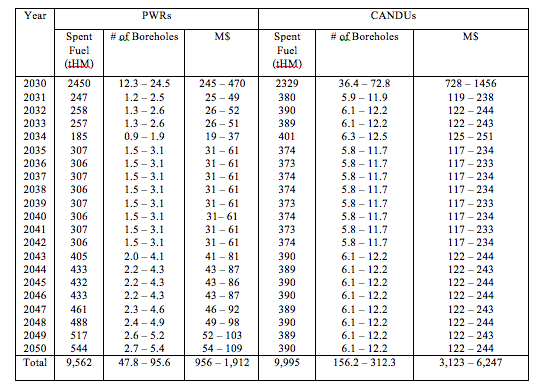by Jungmin Kang
Exploration of the Potential for Deep Borehole Disposal of Nuclear Wastes in South Korea: An Update[1]
1 July 2014
Visiting Professor, KAIST
I. executive summary
Since the Republic of Korea’s first nuclear power reactor was placed into operation in 1978, twenty three reactors have been placed into operation, with a total capacity of 20.7 gigawatts of electricity generation capacity (GWe, or billion watts). Ongoing construction and announced plans will, if fully realized, bring the capacity of South Korea’s nuclear fleet to 43 GWe in 2035. At present, spent fuel from existing reactors is being stored primarily in spent fuel pools at reactor sites. Korea Hydro & Nuclear Power Co., Ltd (KHNP) argues that space in these pools will begin to run out by the middle of this decade. Public concern about the management of spent nuclear fuel has helped to drive a debate about future management options, including “pyroprocessing.” In the pyroprocessing concept, similar to the more standard reprocessing systems in use in Japan and elsewhere, plutoniumis separated from most of the other components of spent fuel so that it can be “recycled” in fast reactors. The difference between pyroprocessing and standard reprocessing is that in pyroprocessing plutonium remains mixed with minor actinides, making it somewhat, though arguably not significantly, less prone to diversion for use in nuclear weapons. Among other arguments, pyroprocessing is touted as a means for reducing the volume required for long-term geologic disposal, presumably in mined repositories, of radioactive materials from the nuclear fuel cycle, thereby reducing the area and volume required for mined repositories.
In recent years, the concept of deep borehole disposal (DBD) of nuclear materials, including, potentially, nuclear spent fuel, high level wastes from reprocessing operations, and possibly plutonium suitably mixed with other materials, has been receiving increasing attention. In the DBD concept, a borehole is drilled into crystalline basement rocks to a depth of 3 to 5 km. The bottom 1-2 km of the borehole is used as the waste disposal zone for hundreds of canisters containing spent fuel or other radioactive materials. The borehole is then filled with a variety of materials and capped and sealed such that the wastes are permanently isolated. The region of crystalline basement rocks where wastes are placed in DBD is hydraulically decoupled from regions of groundwater flow. Low permeability in the deep crystalline basement rocks and the high salinity in the deep aquifers found there increases confidence that eventual impacts on the biosphere by the radioactive wastes disposed of in boreholes can be avoided or reduced to an inconsequential level, even over tens of thousands of years.
Criteria for siting of DBD facilities include crystalline rock at the surface or within 1 km of the surface, and in an area that is tectonically stable, located away from population centers, and not near international borders. Based on these criteria, better sites in the ROK would be toward the north and east of the country, with the northern part of the Korean Peninsula (that is, in the Democratic Peoples’ Republic of Korea) perhaps having the some of best potential sites. Much additional research, however, is required to identify practical candidate locations for DBD in Korea.
The institutional and legal framework of the nuclear industry in the ROK can be summarized as follows. The Ministry of Trade, Industry and Energy (MOTIE, previously the Ministry of the Knowledge Economy) supervises the ROK’s nuclear power program. Established in October 2011, the Nuclear Safety and Security Commission (NSSC) is responsible for nuclear safety regulations including the licensing of nuclear facilities. The Atomic Energy Committee (AEC) under the jurisdiction of the Prime Minister is the supreme organization for decision-making on national nuclear policies. The NSSC under the jurisdiction of the Prime Minister is responsible for matters concerning the safety of nuclear facilities and radioactive waste management. Key ROK National laws related to spent fuel and radioactive waste management are the Atomic Energy Act (AEA) and the Radioactive Waste Management Act (RWMA). A conceptual design for a mined repository for nuclear materials in Korea has been developed by the Korea Atomic Research Institute (KAERI). KAERI’s conceptual geologic repository is designed to be located in granite rocks at depth of 500 m, but a specific repository site has not yet been chosen. Some of the work done in designing and researching this repository concept may be relevant to the further exploration of the DBD concept in the ROK.
As of the end of 2012, 5,829 tons of spent pressurized water reactor (PWR) fuel and 6,878 tons of spent heavy water reactor (HWR) fuel were stored in the spent fuel storage facilities at South Korea’s four NPP sites. Based on current plans for ROK reactor deployment, this study estimates that approximately 52,000 tons of spent PWR fueland 20,000 tons of spent HWR fuel will be generated over the entire lifetimes of the 35 PWR and 4 HWR units that are planned to be deployed by 2035. With these volumes as a starting point, and assuming that spent fuel must cool for 30 years before being placed in deep boreholes, it is estimated—very roughly—that the cumulative cost of for DBD disposal of the ROK’s suitably cooled spent fuel would be in the range of about $4 to $8 billion from 2030 through 2050. Put into perspective, this cost amounts to about $0.001 to $0.002 per kWh of electricity generated in nuclear power plants in the ROK through 2020.
Considering its potential safety superiority compared with normal geologic disposal, deep borehole disposal could be an alternative, which could be more acceptable to local communities, for the eventual disposal of spent fuel and/or HLW in South Korea. The ROK’s involvement in international cooperation on DBD development for nuclear waste disposal is a possibility, particularly if the concept earns favorable public opinion, and if the United States and Japan are seen by ROK officials to be cooperating on DBD development as well.
Further study needs to be done to identify and address relevant technical issues with DBD, as well as to obtain comprehensive public and local opinions on the deep borehole disposal possibility for the ROK.
II. INTRODUCTION
South Korea’s first commercial nuclear power reactor was placed into operation in 1978. Today, the Republic of Korea (ROK) has twenty reactors in operation: 19 pressurized-water reactors (PWRs) with a total electric generating capacity of 17.9 billion watts (GWe) and 4 CANDU heavy-water reactors (HWRs) with a combined electric-power-generation capacity of 2.8 GWe. An additional 5 PWRs (with a total capacity of 6.6 GWe) are under construction to be put into operation by 2018, and plans have been announced to build additional PWRs by 2035. Those additions will bring South Korea’s total nuclear generating capacity up to 43 GWe. [2]
As in other countries with nuclear power plants, South Korea’s public has concerns about the management of radioactive waste. As the available space in at-reactor storage pools become saturated with irradiated fuel assemblies, spent fuel management has become a hot issue. Korea Hydro and Nuclear Power (KHNP), South Korea’s nuclear utility, has asserted that its nuclear power plants will begin to run out of spent-fuel storage capacity in 2016.[3]
At the moment, South Korea’s debate regarding “back-end” nuclear fuel cycle issues (spent fuel management) is focused on “pyroprocessing,” driven by the researchers at the Korean Atomic Energy Research Institute (KAERI). This is partially because Japan has established its own spent fuel reprocessing capacity—and the agencies in the ROK nuclear sector would like to be able to have the same capabilities—and because, although a reprocessing plant could not be put into operation by the time that the PWR spent fuel pools begin to fill up, the expectation that the fuel will ultimately be reprocessed could provide a justification for establishing central storage for spent fuel near the site where the reprocessing plant would be built. Whether or not it pursues reprocessing, South Korea needs sites to accommodate geological repositories for its spent fuel and/or for the high level wastes (HLW) produced during reprocessing.
The deep borehole disposal concept has been recently receiving global attention due to its potential technical and cost advantages when compared with “normal” geologic disposal. The deep borehole concept involves drilling into crystalline basement rocks to a depth of 3 to 5-km, then placing waste canisters in the bottom 1-2 kilometers of the boreholes and capping the borehole such that the wastes are permanently isolated.
This report briefly explores the concept of using deep borehole disposal in South Korea. It begins with a review of international experience to date in evaluating the prospects of deep borehole disposal of nuclear wastes, then provides an initial review of the geologic suitability of the technology for South Korea. The paper offers a review of the institutions, laws, and practices related to spent fuel management in the ROK, and offers tentative conclusions as to the applicability of deep borehole disposal for the nation and the Korean Peninsula.
III. DEEP BOREHOLE DISPOSAL (DBD)
History of DBD
Although evaluation of DBD began in the US in the 1950s,[4] more recent studies, beginning in the 1990s, have added significant to the state of the art in DBD research. A recent MIT study summarized principal earlier studies on DBD as shown in Table 1.[5] A 2003 MIT report recommended that DBD for spent fuel had the potential to significantly reduce risk compared to mined repositories, leading to an on-going project by a joint Sandia National Labs and MIT group to explore DBD as a possible alternative to the (developed but not completed, and recently cancelled) mined repository at Yucca Mountain, in Nevada.[6]
Table 1: Summary Comparison of Deep Borehole Concepts
Concept of DBD
In the DBD concept, a borehole is drilled in crystalline basement rocks to a depth on the order of 5 km. The bottom 1-2 km of the borehole is used as the waste disposal zone, which might hold 200-400 canisters, as shown in Figures 1 and 2.[7] Figure 1 implies that the region of crystalline basement rocks is hydraulically decoupled from regions of groundwater flow. As shown in Figure 2, one such borehole, for example, could hold about 100-200 tonnes heavy-metal (tHM) of spent fuel from pressurized water reactors (PWRs).
Figure 1: Conceptual Model for Deep Borehole Disposal
DBD would have potential advantages over normal geologic disposal, as it would place waste canisters at greater depths, where the hydro-geological conditions are less dynamic, than in conventional mined repositories. This greater depth increases confidence that eventual impacts on the biosphere by the radioactive waste can be avoided or substantially reduced. Low permeability in the deep crystalline basement rocks and the high salinity in the deep aquifers found there suggest that the chances of interaction of wastes with groundwater that could interact with the biosphere should be minimal. Crystalline basement rocks are relatively common at depths of 2 km to 5 km in many countries, leading to wider availability of suitable sites for DBD than for nearer-surface repositories. Along with greater safety through better isolation of wastes from the biosphere, greater security against terrorist diversion of wastes disposed of in DBD and better cost-effectiveness would be additional potential benefits.[8]
Figure 2: Schematic of Deep Borehole Disposal
Site Selection
Heiken et al. list four factors that define an ideal site for DBD as follows.[9]
– Crystalline rock at the surface or within 1 km of the surface.
– A region that is tectonically stable.
– An area located away from population centers.
– A region not near international borders (i.e. >200 km)
Retrievability
The difficulty of retrieving wastes after final repository closure is one of the contentious issues with respect to DBD. The 2009 MIT report summarizes the main arguments for and against retrievable variants of DBD, as shown in Table 2, and reaches the conclusion that non-retrievability/permanent disposal is preferred.[10]
Table 2: Nuclear Spent Fuel Emplacement Options and Strategies
Borehole Drilling Experience
A 2009 MIT report summarizes borehole drilling experience since 1985, as described in Table 3.[11] A 2009 Sandia National Laboratory (US) study estimates a cost of about $20 million for construction of each 5 km-depth borehole, which would require about 110 days to drill, not including emplacement operations, licensing, and other activities. This estimate assumes the use existing drilling technologies.[12]
Table 3: Experience with Deep Boreholes into Crystalline Rock
SUITABILITY OF THE KOREAN PENINSULA FOR GEOLOGIC DISPOSAL
Appropriate siting of DBD is very important to assure the safety of disposal of spent fuel or HLW. The site used should have characteristics suitable to prevent or retard the potential movement of radionuclides from the disposal system to the biosphere. The natural geologic characteristics of the site play an important role in the disposal concept.[13]
A past study[14] provides the following guidelines on desirable site characteristics of DBD, ideally favoring a combination of:
“(1) crystalline rock at the surface or within 1 km of the surface;
(2) a region that is tectonically stable;
(3) an area located away from population centers; and
(4) a region not near international borders”.
Geology of the Korean Peninsula
The Korean peninsula is located between the Eurasian continent and the west Pacific mobile belt. More than half of the exposed area of the peninsula consists of Precambrian metamorphic rocks and Paleozoic-Mesozoic plutonic rocks, whilesedimentary and volcanic rocks of Paleozoic and Mesozoic era are distributed on those basements accompanied with tectonic movement.[13]
Based on these lithological characteristics, formation stages and continuity of geological history, a division of tectonic provinces on the Korean peninsula is shown in Figure 3.[16]
According to a KAERI study,[5] the massif and fold belts are of primary interest among the tectonic units on the Korean peninsula with regard to radioactive waste disposal. The Nangnim massif, Kyonggi massif, and Sobaeksan massif are Archean-early Proterozoic massifs. The Hambuk fold belt and Okchon fold belt are upper Proterozoic-upper Paleozoic fold belts. The Kyonggi massif, Sobaeksan massif and Okchon fold belt are located in the southern part of the Korean peninsula.
It is desirable that DBD facilities be located away from population centers. Figure 4 shows population densities in South Korea as of 2005.[18] Combining consideration of the tectonic provinces and the areas of low population density in South Korea provides a rough idea of which areas of the ROK might be suitable sites for DBD.
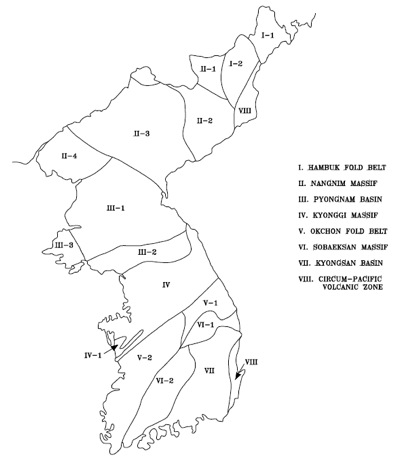 Figure 3: Tectonic Provinces in Korean Peninsula
Figure 3: Tectonic Provinces in Korean Peninsula
Figure 4: Population Density Map of South Korea in 2005 (Legend: persons per sq. km)
Regional Fractures in South Korea
The geology of South Korea shows a few large-scale tectonic fractures, while small-scale fractures are evenly distributed throughout the southern peninsula, as shown in Figure 5.[19]
Figure 5: Fracture Map Superimposed on Tectonic Provinces in South Korea
Seismicity
As the Korean peninsula is located in the area where the Eurasian plate contacts with the west Pacific mobile belt, earthquakes in Korea are ascribed to intra-plate seismicity.[20] Table 4 and Figure 6 show historical seismicity records for the Korean peninsula.[21] Though low-level earthquake activity has been a historical feature of the Korean peninsula, a large portion of the earthquakes that have occurred have been in the southern part of the peninsula.
Table 4: Statistics of Magnitude >4.75 Historical Earthquakes on the Korean Peninsula
Figure 6: Epicentral Distribution of Historical Earthquakes in the Korean Peninsula
Existing Concept of Spent Fuel Disposal System in South Korea (Mined Repository)
For comparison purpose, this study describes below a concept of a Korean disposal system as designed by the Korea Atomic Research Institute (KAERI). KAERI’s conceptual geologic repository is designed to be located in granite rocks at depth of 500 m, although the actual repository site has not been identified or chosen as yet. The layout and other specifics of the repository design are provided in Figure 7 and Table 5.[22] The total capacity of spent fuel disposal in the repository is assumed to be 20,000 tHM of PWR spent fuel and 16,000 tHM of CANDU spent fuel.
According to the KAERI research referenced above, the peak temperature of the bentonite buffer material in which double-walled metal canisters containing spent fuels are buried should be lower than 100 ºC to assure the long term integrity of its physical and chemical properties. With this constraint, the distance between the parallel tunnels in the repository is 40 m, and the minimum distance between two deposition holes for PWR canisters and CANDU canisters are 6 m and 3 m, respectively. These distances are calculated assuming that heat generation is 1,540 W for the PWR canister and 760 W for the CANDU canister, based on spent fuel cooling times of 40 and 30 years, respectively, prior to introduction into the repository. This concept of a disposal system was designed to be used to evaluate the feasibility of a high-level waste/spent fuel disposal system for the ROK, and to help to formulate a listing of the data needed to carry out a long-term safety analysis.[23] Relatively little progress on researching or siting mined repositories in Korea has taken place in recent years.
Figure 7: Layout of the Korean Reference Disposal System
Table 5: Length and the Number of Disposal Tunnels
SPENT FUEL MANAGEMENT IN SOUTH KOREA
Institutional Framework in the Radioactive Waste Management
With regard to the governmental organizations concerned with radioactive waste, the main administrative authority in the ROK has been The Ministry of Trade, Industry and Energy (MOTIE), which supervises the nuclear power program. In addition to MKE, the Nuclear Safety and Security Commission (NSSC), established in October 2011, is responsible for nuclear safety regulations including the licensing of nuclear facilities. The Atomic Energy Committee (AEC) under the jurisdiction of the Prime Minister is the supreme organization for decision-making on national nuclear policies. The NSSC under the jurisdiction of the Prime Minister is responsible for matters concerning the safety of nuclear facilities and radioactive waste management. The NSSC is also responsible for developing licensing criteria for the construction and operation of radioactive waste disposal facilities, developing technical standards for operational safety measures, and for assuring safe management of radioactive waste at every stage of the site selection, design, construction, operation, closure and post-closure of radioactive waste disposal facilities. MOTIE also develops and implements management policies regarding radioactive waste treatment, storage and disposal. These policies are prepared by MOTIE and deliberated by the AEC before implementation.[24]
Legal Framework in the Radioactive Waste Management
Key ROK National laws related to spent fuel and radioactive waste management are the Atomic Energy Act (AEA) and the Radioactive Waste Management Act (RWMA). The AEA provides for matters concerning safety regulations, including permission for construction and operation of radioactive waste disposal facilities. The RWMA, which determines all aspects of managing radioactive waste, was announced on March 28, 2008, and was enacted on March 31, 2010. Based on the RWMA, the Korea Radioactive Waste Management Organization and the Radioactive Waste Management Fund were established. According to the RWMA, KHNP, the utility company, should annually deposit to the Fund payments toward the ultimate cost of decommissioning of nuclear power plants, disposal of low and intermediate level waste (LILW), and spent fuel management. Figure 8 shows the financing structure for radioactive waste management in South Korea.[25]
Figure 8: Financing Structure of Radioactive Waste Management in South Korea
Current Practice in the Management of the Spent Fuel
At its 253rd meeting in 2004, the AEC announced that national policy for spent fuel management would be decided later in consideration of progress of domestic and international technology development, and that spent fuel would be stored at a reactor site by 2016 under KHNP’s responsibility, using existing spent fuel pools at reactor sites.[26] As noted above, South Korea has not decided whether to directly dispose of or recycle spent fuel. Currently, South Korea has no national plan for geologic disposal of spent fuel or HLW. As a consequence, there are no regulatory and licensing arrangements that would be relevant to DBD in South Korea.
A Korea Radioactive Waste Agency (KORAD) report assumes operation of AR and/or AFR interim dry storage of spent fuel in around early 2020s, operation of geologic disposal site for CANDU spent fuel in around 2050, and operation of geologic disposal site for PWR spent fuel and/or HLW from pyroprocessing in around 2070.[27]
Status of and Future Prospects for Nuclear Power in South Korea
As described in the introductory part of this report, currently in South Korea 19 PWRs and 4 HWRs are in operation, with 5 PWR units under construction and due to be completed by 2018, and 11 more PWRs to deployed by 2035. Table 6 shows the generating capacities and expected initial operating dates of South Korea’s power reactors through 2024.[28]
Table 6: Current and Planned Nuclear Power Capacity in South Korea through 2024[29]
Status and Prospect of Spent Fuel Generation
As of the end of 2009, 4,867 tons of spent PWR fuel and 5,894 tHM of spent HWR fuel were stored in the spent fuel storage facilities at South Korea’s four NPP sites. As of 2012, the total spent fuel in storage at these four sites included 5,829 tHM of PWR fuel and 6,878 tHM of HWR fuel. Table 7 shows the spent fuel inventories at the four sites as of the end of 2009. According to an analysis by the operator, KHNP, the saturation dates for the current storage at the Kori, Yonggwang and Ulchin sites for spent PWR fuel, and at the Wolsong site for spent HWR fuel, will be 2016, 2021, 2018 and 2017 respectively.[30]
Projections of spent fuel generation depend on the capacity factors of the reactors (that is, what fraction of the time they operate and at what average fraction of their nominal capacities), and the burnup of spent fuel (that is, the number of megawatt-days of heat that can be generated from a kilogram of fuel before it is “spent”). The average discharged burnup level for spent PWR fuel is around 50,000 MWd/tHM in today’s reactors.[1] Heavy-water reactors are fueled with natural uranium, and the burnup rate is about 7,100 MWd/tHM. Assuming that all NPPs have thermal efficiencies of 33% and capacity factors of 90 percent, which is reasonably consistent with ROK experience, the projections of cumulative spent fuel generation in South Korea from reactors completed by 2030 are given in Figure 9 for the years 2010 through 2050. This study estimates that approximately 52,000 tons of spent PWR fuel and approximately 20,000 tHM of spent HWR fuel will be generated over the entire lifetimes (that is, until each unit is decommissioned, whether before or after 2050) of the 35 PWR and 4 HWR units that will be deployed by 2030.
Figure 9: Cumulative Inventory of Spent Fuel Generation in South Korea from Reactors Deployed by 2035[33]
Rough Cost Estimation of DBD Implementation
To estimate what the DBD option might cost as a spent fuel disposal option for South Korea, the author made the assumption that 200-400 canisters containing a total of about 100-200 tHM of spent PWR fuel can be accommodated in a borehole in crystalline basement rocks on the order of 5 km deep with a 1-2 km long waste disposal zone, while one borehole might hold about 1,600-3,200 canisters containing about 32-64 tHM spent HWR fuel, assuming a canister length of 0.6 m.[34]
Table 8 shows the roughly-estimated annual costs of DBD construction through 2050 to accommodate the ROKs spent fuel that has cooled for approximately 30 years to that date. These costs are, based on an estimated cost of about $20 million for construction of each 5 km-depth borehole, as included in the 2009 Sandia National Laboratory study referenced above[35]. The costs shown do not include any additional costs for items such as administration cost, and reflect an assumption of no real escalation (or reduction due to learning) in costs assumed. 2030 is assumed to be the start year for borehole disposal. Table 8 shows the amount of spent fuel disposed of annually, as well as the number of boreholes needed to dispose of cooled spent fuels using DBD from 2030 through 2050. Spent fuel disposal by year is based on historical spent fuel quantities removed from ROK reactors through 2012. So, for example, the quantity of PWR fuel shown as being sent to borehole disposal in 2033 is the amount removed from reactor cores in 2003. After 2012, the estimates of annual new spent fuel production implied by Figure 9, plus 30 years, are used to estimate the amount of spent fuel sent to disposal.
Due to the larger volume of spent fuel discharged, the cumulative cost of DBD for CANDU (HWR) spent fuel for 2030 – 2050 is three times greater than that of PWR spent fuel, despite the fact that PWRs produce much more of the ROK’s electricity than HWRs. To reduce the cost of DBD, CANDU spent fuel needs to be more densely packed into canisters before it is subjected to deep borehole disposal.
Table 8: Estimated Annual Cost of DBD Construction from 2030 through 2050 to Accommodate ROK Spent Nuclear Fuel
Overall, Table 8 shows that the undiscounted cost of disposing of the spent fuel generated in the ROK and sufficiently cooled (30 years) for DBD disposal are in the range of about $4 to $8 billion from 2030 through 2050. Put into perspective, this cost amounts to about $0.001 to $0.002 per kWh of electricity generated in nuclear power plants in the ROK through 2020.
Recent Public Opinion of Local Communities
The author of this report, Jungmin Kang, undertook a week-long research trip to South Korea’s four NPPs sites in mid-September 2010. The followings are his key findings from the trip:
– The local people[1] who live near nuclear power plants sites are not aware of the safety superiority of dry cask storage of spent fuel, when compared with pool storage, and are also not aware of the potential safety superiority of deep borehole disposal of spent fuel, compared with normal geologic disposal.
– Local people showed an interest in considering on-site dry cask storage of spent fuel as well as possible in-situ deep borehole disposal if the safety of those options were assured by reliable experts and the local sites are properly compensated financially.
– Educating local people will be very important to achieving on-site dry cask storage of spent fuel as well as possibly in-situ deep borehole disposal in South Korea.
Political and Legal Issues
Implementation of DBD for spent fuel in South Korea would have political implications. The South Korean nuclear fuel cycle community, represented by KAERI, strongly insists on pyroprocessing as its favored alternative for future spent fuel management in the ROK, and would not support any kind of direct disposal of spent fuel in South Korea. Locals living near nuclear facilities, on the other hand, have as their major goal safe geologic disposal of spent fuel and/or HLW.
There are no current legal issues that might affect the practicality of borehole disposal of spent fuel in South Korea, since the current South Korean Atomic Energy Act does not includes any articles relevant to spent fuel disposal.
International Cooperation
A 2010 MIT study recommends research and development of deep borehole disposal for spent fuel and HLW management,[2] based on recent relevant research including a collaborative study done by MIT and Sandia National Laboratories.[38]
The US – Japan Joint Nuclear Energy Action Plan, a process started in 2007, reached a similar conclusion in its May 2010 report of Phase I of its Waste Management Working Group, as follows:[39]
“… we view the deep borehole disposal approach as a promising extension of geological disposal, with greater siting flexibility and the potential to reduce the already very low risk of long-term radiation exposure to still lower levels without incurring significant additional costs.”
Based on the results of these studies, opportunities for cooperation jointly with the US and Japan on DBD would help to spur interest in the South Korean nuclear (scientific and policy) community in DBD evaluation and consideration.
IV. CONCLUSION
Considering its potential safety superiority when compared with normal geologic disposal, deep borehole disposal could be an alternative, which could be more acceptable to local communities, for the eventual disposal of spent fuel and/or HLW in South Korea.
Further study needs to be done to identify relevant technical issues, as well as to obtain comprehensive public and local opinions on the deep borehole disposal possibility for the ROK.
A government-supported committee for public consultation on spent fuel management in Korea was established in October 2013. The 13 committee members are from academia, local communities, and non-governmental organizations. The committee plans to provide recommendations to the South Korean government on spent fuel management by the end of 2014 after a public consultation process including meetings, seminars, fora, surveys, and other events and activities.[40] The results of this process are expected to critically affect nuclear fuel cycle activities and development, including deep borehole disposal, in the ROK in the coming years.
V. REFERENCES
[1]This paper provides an update of Kang’s 2010 work, An Initial Exploration of the Potential for Deep Borehole Disposal of Nuclear Wastes in South Korea, NAPSnet Special Report dated December 13, 2010, and available as http://nautilus.wpengine.netdna-cdn.com/wp-content/uploads/2011/12/JMK_DBD_in_ROK_Final_with_Exec_Summ_12-14-102.pdf.
[2] Ministry of Trade, Industry and Energy, The 2nd National Energy Basic Plan, January 2014 (Korean); Ministry of Trade, Industry and Energy, The 6th Basic Plan for Long-Term Electricity Supply and Demand (2013 ~ 2027), January 2013 (Korean).
[3] Ki-Chul Park, “Status and Prospect of Spent Fuel Management in South Korea,” Nuclear Industry, August 2008 (Korean).
[4]Peter Swift, “Goals for a Deep Borehole Disposal Workshop,” SNL-MIT Workshop on Deep Borehole Disposal, Washington, DC, March 15, 2010. Available in www.mkg.se/uploads/SNL_MIT_borehole_workshop_report_final_100507.pdf.
[5] Table 1 is taken from Table 1.1 in Benyamin Sapiie and Michael J. Driscoll, A Review of Geology-Related Aspects of Deep Borehole Disposal of Nuclear Wastes: For the MIT Study on The Future of the Nuclear Fuel Cycle, MIT-NFC-TR-109, August 2009, available as http://web.mit.edu/miteicomm/web/boreholes-MIT-NFC-TR-109.pdf.
[6]Fergus Gibb, “Deep borehole disposal (DBD) methods,” Nuclear Engineering International, 25 March 2010
[7]Patrick V. Brady et al., Deep Borehole Disposal of High-Level Radioactive Waste, SAND2009-4401, August 2009; N. Chapman and F. Gibb, “A truly final waste management solution,” Radwaste Solutions 10/4, p.26-37 (2003); Michael J. Driscoll, “A Case for Disposal of Nuclear Waste in Deep Boreholes,” SNL-MIT Workshop on Deep Borehole Disposal, Washington, DC, March 15, 2010.
[8]Bill W. Arnold et al., “Into the deep,” Nuclear Engineering International, 25 March 2010; Gibb, F.G.F., Taylor, K.J. and Burakov, B.E. “The ‘granite encapsulation’ route to the safe disposal of Pu and other actinide,” Journal of Nuclear Materials, Volume 374 (3), p.364 – 369(2008). As shown in Figure 2, the waste at the bottom of the borehole would be protected by 3-4 km of clay and concrete plugs and backfill, requiring a major drilling operation to penetrate to where the wastes have been buried, and making it highly unlikely that a terrorist group could access the wastes undetected.
[9] Heiken, G, Woldegabriel, G, Morley, R, Plannerer, H and Rowley, J. Disposition ofexcess weapons plutonium in deep boreholes – Site selection handbook. Report ofthe Los Alamos National Laboratory, Report LA-13168-MS. 1996.
[10] Table 2 taken from Table 4.1 of Benyamin Sapiie and Michael J. Driscoll, A Review of Geology-Related Aspects of Deep Borehole Disposal of Nuclear Wastes: For the MIT Study on The Future of the Nuclear Fuel Cycle, MIT-NFC-TR-109, August 2009.
[11] Table 3 taken from Table 2.4 of Benyamin Sapiie and Michael J. Driscoll, A Review of Geology-Related Aspects of Deep Borehole Disposal of Nuclear Wastes: For the MIT Study on The Future of the Nuclear Fuel Cycle, MIT-NFC-TR-109, August 2009.
[12]Patrick V. Brady et al., Deep Borehole Disposal of High-Level Radioactive Waste, SAND2009-4401, August 2009.
[13]IAEA, Siting of Geological Disposal Facilities: A Safety Guide, Safety Series No. 111-G-41 (1994).
[14] At an ideal site for DBD, it must be demonstrated that there is no fluid movement from the bottom of the borehole at a depth of 4 kilometers and there will be no significant migration over the next million years.Grant Heiken et al., Disposition of Excess Weapon Plutonium in Deep Boreholes: Site Selection Handbook, LA-13168-MS, September 1996.
[15]C.S.Kim et al., “Lithological Suitability for HLW Repository in Korea,” Proceedings of Symposium entitled Technologies for the Management of Radioactive Waste from Nuclear Power Plants and Back End Nuclear Fuel Cycle Activities, Taejon, Republic of Korea, 30 August – 3 September 1999.
[16]Ibid.
[17]Ibid.
[18]Modified from “Statistics Korea” (http://atlas.ngii.go.kr/map/territory.jsp?fcode=03)
[19]C.S.Kim et al., “Lithological Suitability for HLW Repository in Korea,” Proceedings of Symposium entitled Technologies for the Management of Radioactive Waste from Nuclear Power Plants and Back End Nuclear Fuel Cycle Activities, Taejon, Republic of Korea, 30 August – 3 September 1999.
[20]Ibid.
[21]Wenjie Zhai et al., “Research in historical earthquakes in the Korean peninsula and its circumferential regions,” Acta Seismologica Sinica, Vol.17, No.3, p.366-371, May 2004.
[22]Jongyoul Lee et al., “Concept of a Korean Reference Disposal System for Spent Fuels,” Journal of Nuclear Science and Technology, Vol.44, No.12, p.1565-1573, 2007. Available as http://www.jstage.jst.go.jp/article/jnst/44/12/1565/_pdf.
[23]Ibid.
[24] OECD Nuclear Energy Agency (2010), Radioactive Waste Management in Rep. of Korea, available as http://www.oecd-nea.org/rwm/profiles/Korea_report_web.pdf.
[25]Ibid.
[26]253rd meeting of Korea AEC in 2004. See, for example, Ministry of Education, Science & Technology, Korean Third National Report under the Joint Convention on the Safety of Spent Fuel Management and on the Safety of Radioactive Waste Management, dated October, 2008, and available as www.kins.re.kr/pdf/Korean%20Third%20National%20Report%202008.pdf.
[27] Korea Radioactive Waste Agency (KORAD, previously KRMC), “Alternatives and Roadmap of Spent Fuel Management in South Korea,” Final report prepared by Korean Nuclear Society, Korean Radioactive Waste Society and Green Korea 21, August 2011 (Korean)
[28]http://www.khnp.co.kr/en/03000100; http://www.khnp.co.kr/en/030100; Ministry of Trade, Industry and Energy, The 6th Basic Plan for Long-Term Electricity Supply and Demand (2013 ~ 2027), January 2013 (Korean).
[29] J.H. Mok et al., Examination on Amount of Spent Fuel Stored and Verification on Saturation Time of Pool Capacities, Kookmin University, May 2009 (in Korean).
[30] Ki-Chul Park, “Status and Prospect of Spent Fuel Management in South Korea,” Nuclear Industry, August 2008 (in Korean).
[31] Ministry of Trade, Industry and Energy (MOTIE), “Status of Spent Fuel Management and Plan for Public Consultation Process,” May 2013 (Korean)..
[32] Based on an initial uranium enrichment in fresh PWR fuel of 4.5 percent, J.H. Mok et al., Examination on Amount of Spent Fuel Stored and Verification on Saturation Time of Pool Capacities, Kookmin University, May 2009 (Korean); The Future of Nuclear Power: An Interdisciplinary MIT Study, MIT, p. 119 (2003).
[33] The assumed 60 and 50-year operating lives for PWRs and HWRs, respectively, are based on the 1st National Energy Basic Plan (2008-2030).
[34] Typical HWR fuel, for example, in a CANDU fuel bundle, is about 50 cm in length, 10 cm in diameter, and weighs about 20 kg HM. http://en.wikipedia.org/wiki/Nuclear_fuel#CANDU_fuel.
[35] Patrick V. Brady et al., Deep Borehole Disposal of High-Level Radioactive Waste, SAND2009-4401, August 2009.
[36] Local people mentioned at this report are representatives of non-governmental organizations based near reactor sites who Jungmin Kang met during his trips in mid-September 2010.
[37] MIT, The Future of the Nuclear Fuel Cycle: An Interdisciplinary MIT Study (2011). Available as http://mitei.mit.edu/publications/reports-studies/future-nuclear-fuel-cycle.
[38]Patrick V. Brady and Michael J. Driscoll, Deep Borehole Disposal of Nuclear Waste: Report from a Sandia-MIT Workshop on March 15, 2010 in Washington, DC. Dated May 7, 2010, available as www.mkg.se/uploads/SNL_MIT_borehole_workshop_report_final_100507.pdf.
[39]Information Basis for Developing Comprehensive Waste Management System – US-Japan Joint Nuclear Energy Action Plan Waste Management Working Group Phase I Report, FCR&D-USED-2010-000051, Published Jointly as JAEA-Research-2010-015, May 2010. Available as www.ipd.anl.gov/anlpubs/2010/05/67013.pdf.
[40] A public consultation committee on spent fuel, “Action Plan for Public Consultation Process on Spent Fuel,” January 29, 2014 (Korean).
VI. NAUTILUS INVITES YOUR RESPONSES
The Nautilus Peace and Security Network invites your responses to this report. Please leave a comment below or send your response to: nautilus@nautilus.org. Comments will only be posted if they include the author’s name and affiliation.



